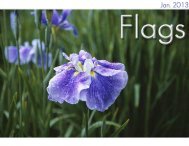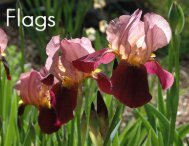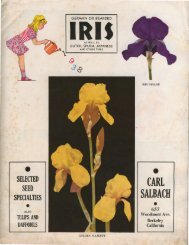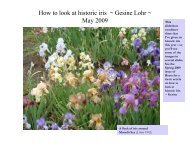Irises - Historic Iris Preservation Society
Irises - Historic Iris Preservation Society
Irises - Historic Iris Preservation Society
Create successful ePaper yourself
Turn your PDF publications into a flip-book with our unique Google optimized e-Paper software.
8 PRESENT-DAY GARDENING<br />
bulbous plants such as Moraeas, which used, indeed,<br />
formerly to be classed with <strong><strong>Iris</strong>es</strong>. But what is the difference<br />
between an <strong>Iris</strong> and a Moraea ? The standard book<br />
on the Irideae affords us no further light on this question<br />
than that <strong><strong>Iris</strong>es</strong><br />
grow north of the Equator and Moraeas<br />
south of it ! This may be true, but it is<br />
hardly scientific,<br />
although it would certainly add to the interest with which<br />
the botanical world would await the first flowering of any<br />
bulbous plants that might be brought from the temperate<br />
regions on the Kenia and Kilimanjaro Ranges, which lie<br />
almost directly under the Equator in Central Africa. As<br />
a matter of fact <strong><strong>Iris</strong>es</strong> are only separated from Moraeas<br />
by the existence of a tube, however short, between the<br />
ovary and the base of the segments of the perianth. In<br />
a Moraea, the divisions of the flower rise directly from<br />
the top of the ovary without the intervention of any tube.<br />
The six segments of the flowers of an <strong>Iris</strong> are popularly<br />
known as the "standards" and the "falls." The terms<br />
are convenient, but nevertheless inappropriate when applied<br />
to such groups as that of the Juno <strong><strong>Iris</strong>es</strong>, where the standards<br />
are either horizontal or drooping, while the falls<br />
stand up<br />
at an angle of at least 45. In addition to these six<br />
segments, there are the three style branches, which arch<br />
over the anthers and bear on their under side near the<br />
extremity the stigmatic surface, through which the flower<br />
is fertilised. The style branches form the roof and the<br />
haft of the falls the floor of a kind of tunnel. The<br />
stigma projects downwards at the mouth of this tunnel,<br />
along the roof of which lie the anthers. These bear the<br />
pollen, and at their base exudes the nectar which entices<br />
the insects.











